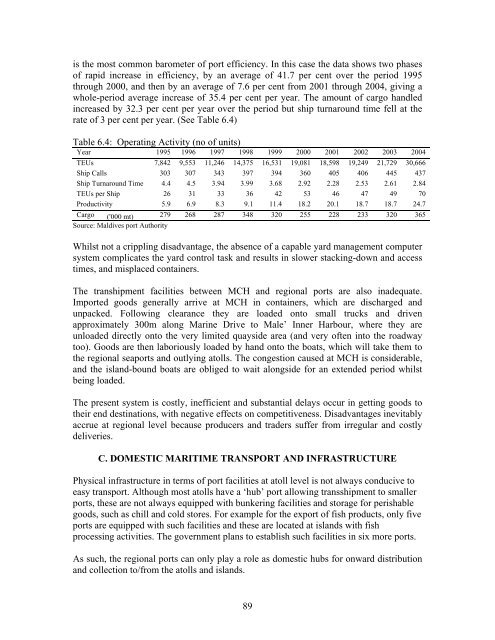DTIS, Volume I - Enhanced Integrated Framework (EIF)
DTIS, Volume I - Enhanced Integrated Framework (EIF)
DTIS, Volume I - Enhanced Integrated Framework (EIF)
You also want an ePaper? Increase the reach of your titles
YUMPU automatically turns print PDFs into web optimized ePapers that Google loves.
is the most common barometer of port efficiency. In this case the data shows two phases<br />
of rapid increase in efficiency, by an average of 41.7 per cent over the period 1995<br />
through 2000, and then by an average of 7.6 per cent from 2001 through 2004, giving a<br />
whole-period average increase of 35.4 per cent per year. The amount of cargo handled<br />
increased by 32.3 per cent per year over the period but ship turnaround time fell at the<br />
rate of 3 per cent per year. (See Table 6.4)<br />
Table 6.4: Operating Activity (no of units)<br />
Year 1995 1996 1997 1998 1999 2000 2001 2002 2003 2004<br />
TEUs 7,842 9,553 11,246 14,375 16,531 19,081 18,598 19,249 21,729 30,666<br />
Ship Calls 303 307 343 397 394 360 405 406 445 437<br />
Ship Turnaround Time 4.4 4.5 3.94 3.99 3.68 2.92 2.28 2.53 2.61 2.84<br />
TEUs per Ship 26 31 33 36 42 53 46 47 49 70<br />
Productivity 5.9 6.9 8.3 9.1 11.4 18.2 20.1 18.7 18.7 24.7<br />
Cargo ('000 mt) 279 268 287 348 320 255 228 233 320 365<br />
Source: Maldives port Authority<br />
Whilst not a crippling disadvantage, the absence of a capable yard management computer<br />
system complicates the yard control task and results in slower stacking-down and access<br />
times, and misplaced containers.<br />
The transhipment facilities between MCH and regional ports are also inadequate.<br />
Imported goods generally arrive at MCH in containers, which are discharged and<br />
unpacked. Following clearance they are loaded onto small trucks and driven<br />
approximately 300m along Marine Drive to Male’ Inner Harbour, where they are<br />
unloaded directly onto the very limited quayside area (and very often into the roadway<br />
too). Goods are then laboriously loaded by hand onto the boats, which will take them to<br />
the regional seaports and outlying atolls. The congestion caused at MCH is considerable,<br />
and the island-bound boats are obliged to wait alongside for an extended period whilst<br />
being loaded.<br />
The present system is costly, inefficient and substantial delays occur in getting goods to<br />
their end destinations, with negative effects on competitiveness. Disadvantages inevitably<br />
accrue at regional level because producers and traders suffer from irregular and costly<br />
deliveries.<br />
C. DOMESTIC MARITIME TRANSPORT AND INFRASTRUCTURE<br />
Physical infrastructure in terms of port facilities at atoll level is not always conducive to<br />
easy transport. Although most atolls have a ‘hub’ port allowing transshipment to smaller<br />
ports, these are not always equipped with bunkering facilities and storage for perishable<br />
goods, such as chill and cold stores. For example for the export of fish products, only five<br />
ports are equipped with such facilities and these are located at islands with fish<br />
processing activities. The government plans to establish such facilities in six more ports.<br />
As such, the regional ports can only play a role as domestic hubs for onward distribution<br />
and collection to/from the atolls and islands.<br />
89
















